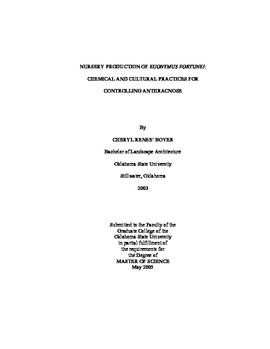| dc.contributor.advisor | Cole, Janet C. | |
| dc.contributor.author | Boyer, Cheryl ReNee' | |
| dc.date.accessioned | 2014-04-15T22:32:19Z | |
| dc.date.available | 2014-04-15T22:32:19Z | |
| dc.date.issued | 2005-05-01 | |
| dc.identifier.uri | https://hdl.handle.net/11244/9582 | |
| dc.description.abstract | Euonymus fortunei (Turcz.) Hand.-Mazz. is a popular landscaping shrub that is extensively produced by commercial nurseries. However, it suffers during production from symptoms of anthracnose caused by the fungus Colletotrichum gloeosporioides (Penz.) Penz. & Sacc. Symptoms include leaf and stem lesions, defoliation and stem dieback. Cultivars tested included 'Emerald 'n Gold', 'Emerald Gaiety' and 'Canadale Gold'. The objectives of this research were to 1) determine the effect of copper sulfate pentahydrate and mancozeb on C. gloeosporioides growing on E. fortunei in production and in vitro and 2) determine the effect of growing plants on plastic or gravel beds with or without periodic sodium hypochlorite treatment on incidence of C. gloeosporioides on E. fortunei. In the fungicide study, cultivar differences existed at each rating date. Disease ratings of 'Canadale Gold' were among the lowest of the cultivars at both sites during both years. 'Emerald 'n Gold' generally had higher ratings than 'Emerald Gaiety' in 2003 at both sites and in 2004 at Stillwater, but 'Emerald Gaiety' generally had higher disease ratings than 'Emerald 'n Gold' at Park Hill in 2004. Copper sulfate pentahydrate at 0.6 g a.i.·L-1 reduced disease ratings of C. gloeosporioides on E. fortunei; however, plants sprayed with mancozeb had lower disease ratings than those sprayed with copper sulfate pentahydrate. Of the fungicides tested in vitro, mancozeb reduced mycelial growth of C. gloeosporioides more than copper sulfate pentahydrate which provided minimal mycelial inhibition. In the cultural control study, no interaction existed between bed type and sodium hypochlorite treatments. Application of sodium hypochlorite did not reduce disease incidence compared to no application. Disease ratings were lower with plastic than with gravel. Disease incidence decreased linearly as the season progressed. | |
| dc.format | application/pdf | |
| dc.language | en_US | |
| dc.publisher | Oklahoma State University | |
| dc.rights | Copyright is held by the author who has granted the Oklahoma State University Library the non-exclusive right to share this material in its institutional repository. Contact Digital Library Services at lib-dls@okstate.edu or 405-744-9161 for the permission policy on the use, reproduction or distribution of this material. | |
| dc.title | Nursery Production of Euonymus fortunei: Chemical and Cultural Practices for Controlling Anthracnose | |
| dc.type | text | |
| dc.contributor.committeeMember | Smith, Michael W. | |
| dc.contributor.committeeMember | Conway, Kenneth E. | |
| osu.filename | Boyer_okstate_0664M_1277.pdf | |
| osu.college | Agricultural Sciences and Natural Resources | |
| osu.accesstype | Open Access | |
| dc.description.department | Horticulture and Landscape Architecture Department | |
| dc.type.genre | Thesis | |
| dc.subject.keywords | euonymus fortunei | |
| dc.subject.keywords | anthracnose | |
| dc.subject.keywords | colletotrichum gloeosporioides | |
| dc.subject.keywords | mancozeb | |
| dc.subject.keywords | copper sulfate pentahydrate | |
| dc.subject.keywords | trifloxystrobin | |
